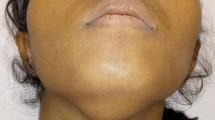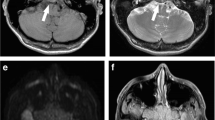Abstract
Background
Ectopic thyroid is a developmental anomaly of the thyroid gland of embryological origin. Instead of having a pretracheal situation, thyroid tissue is elsewhere, most commonly in the median cervical line along the course of the thyroglossal duct. Lingual thyroid is the most common presentation. Ectopic thyroid tissue in the submandibular region has been rarely reported.
Case presentation
We report herein a case of a 65-year-old man admitted to our department with a complaint of a painless swelling in the left submandibular region.
Conclusions
Thyroid gland ectopia should be considered among the differential diagnoses of submandibular swelling. Ectopic thyroid tissue can present with the same pathology affecting the normal thyroid gland such as malignancy and hyperthyroidism.
Similar content being viewed by others
Background
The thyroid gland develops and descends to its final position, anterolaterally to second and fourth tracheal cartilages, by the eighth week of gestation. A defect of migration can give rise to ectopic thyroid tissue. It is typically encountered in the midline cervical region. Laterally located ectopic thyroid tissue, with or without pathology, is a rare condition. Having a functional orthotopic thyroid gland and submandibular ectopic thyroid tissue is an exceptional event [1].
Case presentation
A 65-year-old man was admitted to our Department of Otorhinolaryngology-Head and Neck Surgery for the management of a painless left submandibular swelling evolving for 4 months. There were no signs of thyroid dysfunction and no history of dysphagia or dyspnea. Physical examination revealed a firm mobile mass of about 4 cm in the left submandibular region with no other cervical tumefactions besides enlargement of the thyroid gland. Thyroid function tests were normal. Ultrasound of the neck revealed a large echogenic solid lesion of the left submandibular region distinct from the submandibular gland that was normal-looking and a diffusely enlarged heterogeneous thyroid gland suggestive of a goiter. Fine needle aspiration cytology (FNAC) of the submandibular mass was non-diagnostic.
Head and neck computed tomography (CT) revealed a well-defined intensely enhancing soft tissue mass in the left submandibular region (Fig. 1), responsible for a discrete mass effect on the parapharyngeal space medially. The thyroid gland was slightly enlarged with no suspicious nodules or associated cervical lymphadenopathy (Fig. 2).
There was no operative indication for the thyroid gland on the preoperative data. However, a verification of the submandibular mass was required.
The patient underwent a complete surgical resection of the submandibular mass under general anesthesia. The histopathologic finding was normal thyroid tissue and no features of malignancy (Fig. 3).
The postoperative period was uneventful. The patient was symptom-free and euthyroid over the following year.
Discussion
The thyroid gland is the first endocrine gland to develop in the embryo. It is derived from one median and two lateral anlages that fuse and entail a middle descent to reach their final position by the eighth week of gestation. Failure of the normal descent of the thyroid gland results in ectopic thyroid tissue [2]. The prevalence of ectopic thyroid tissue is nearly 1/100,000–300,000. The male/female ratio is 1/4. Ectopic thyroid tissue can be seen in any situation on the migration pathway of the thyroid gland, from the foramen caecum to the mediastinum [3, 4]. It is typically encountered in the midline cervical region. The presence of normal thyroid tissue laterally in the neck has rarely been described [5, 6].
A failure of the lateral anlage to fuse with the median anlage or an aberrant migration with cell rests deposited laterally during the development of the gland can result in the development of lateral aberrant thyroid tissue. Other possible causes include implantation of thyroid tissue during surgery of a normal localized thyroid gland or metastasis of a thyroid carcinoma [7, 8].
The common differential diagnoses of a submandibular mass are lymphadenopathy of various etiologies, submandibular inflammatory or malignant lesions, or tumors of the inferior pole of the parotid gland. Although rare, thyroid ectopia should be considered among the differential diagnoses of a submandibular mass, independent of the submandibular gland, as is the case in our observation [9, 10].
Ectopic thyroids are usually asymptomatic and may become clinically evident with the development of goiters, hyperthyroidism, or malignancy.
Scintigraphy with technetium (Tc 99m) and iodine, in association with ultrasonography and fine needle biopsy (FNB), plays an important role in the diagnosis of ectopic thyroid tissue [11]. Thyroid scintigraphy scanning detects all sites of thyroid tissue as well as hyper-functional parenchyma [12]. FNB, when conclusive, contributes to the preoperative diagnosis and appropriate therapeutic approach. It has high diagnostic accuracy in the differentiation of benign and malignant processes with an increased sensitivity when biopsy is performed under ultrasound guidance [11].
We managed our case as a submandibular mass of unknown etiology. The likelihood of an ectopic thyroid tissue was low in particular with the evidence of an orthotopic thyroid gland on radiological evaluation. Therefore, scintigraphy was not performed. FNB was non-diagnostic so that surgery became essential.
Submandibular ectopic thyroid has to be differentiated from metastatic thyroid cancer. The rate of malignant transformation in ectopic thyroid is comparable to that in normally located thyroid [13].
Ectopic parenchyma may also be dysfunctional. Eli et al. [14] reported a rare case of ectopic submandibular thyroid causing hyperthyroidism in a patient with a submandibular mass and pre-existing thyroid disease that presents with a deteriorating thyroid function of no apparent reason. The resection of the submandibular mass, which proved to be of a thyroid nature, allowed the correction of the thyroid function.
The therapy of choice for ectopic thyroid tissue is its surgical removal. However, before surgery, it is necessary to ensure that other orthotopic thyroid tissues are functional to avoid the risk of iatrogenic hypothyroidism. In fact, in cases of lateral cervical ectopic thyroid with simultaneous eutopic thyroid, which is a rare situation, the ectopic tissue may be the only functional up to 70% [15, 16].
The treatment of ectopic thyroid depends on its size, local symptoms, functional status of the thyroid gland, and complications [15].The surgical indications for an ectopic thyroid tissue include the risk of malignancy, refractory hyperthyroidism, signs of compression, or esthetic deformity [17].
Conclusion
Our case highlights the diagnostic and therapeutic challenges that are posed by the presence of ectopic thyroid tissue in the submandibular region. The diagnosis of ectopic thyroid, whether normal or pathological, should be considered in case of uncommon submandibular tumefaction. The diagnosis should be made, at best, preoperatively, for a better therapeutic decision.
Availability of data and materials
The datasets used and analyzed during the current study are available from the corresponding author on reasonable request.
Abbreviations
- FNAC:
-
Fine needle aspiration cytology
- CT scan:
-
Computed tomography scan
- FNB:
-
Fine needle biopsy
- Tc 99m:
-
Scintigraphy with technetium 99
References
Mace AT, McLaughlin I, Gibson IW, Clark LJ (2003) Benign ectopic submandibular thyroid with a normotopic multinodular goitre. J Laryngol Otol. 117(9):739–740. https://doi.org/10.1258/002221503322334648
Choi JY, Kim JH (2008) A case of an ectopic thyroid gland at the lateral neck masquerading as a metastatic papillary thyroid carcinoma. J Korean Med Sci. 23(3):548–550. https://doi.org/10.3346/jkms.2008.23.3.548
Feisal TK, Prepageran N, Shahrizal T, Zulkiflee AB (2008) Unusual parapharyngeal lesion: aberrant thyroid gland. Singapore Med J. 49(5):137–138
Mutlu V (2014) Ectopic thyroid tissue in submandibular and infrahyoid region. Eurasian J Med. 46(3):216–219. https://doi.org/10.5152/eajm.2014.34
Çeliker M, Beyazal Çeliker F, Turan A, Beyazal M, Beyazal PH (2015) Submandibular lateral ectopic thyroid tissue: ultrasonography, computed tomography, and scintigraphic findings. Case Rep Otolaryngol. 2015:769604
Akoz T, Erdogan B, Ayhan M, Cinar F (1998) Ectopic submandibular thyroid tissue. Rev Laryngol Otol Rhinol. 119(5):323–325
Zieren J, Paul M, Scharfenberg M, Menenakos C (2006) Submandibular ectopic thyroid gland. J Craniofac Surg. 17(6):1194–1198. https://doi.org/10.1097/01.scs.0000246502.69688.60
Bhardwaj AK, Mani V, Dixit R, Garg A (2016) Ectopic goitrous submandibular thyroid with goitrous orthotopic thyroid gland. Indian J Radiol Imaging. 26(2):245–248. https://doi.org/10.4103/0971-3026.184420
Feller KU, Mavros A, Gaertner HJ (2000) Ectopic submandibular thyroid tissue with a coexisting active and normally located thyroid gland: case report and review of literature. Oral Surg Oral Med Oral Pathol Oral Radiol Endod. 90(5):618–623. https://doi.org/10.1067/moe.2000.108804
Wang YJ, Chu PY, Tai SK (2010) Ectopic thyroid papillary carcinoma presenting as bilateral neck masses. J Chin Med Assoc. 73(4):219–221. https://doi.org/10.1016/S1726-4901(10)70046-0
Gekeli M, Apergis S, Klapsinou E, Galiatsatos N, Proestou D, Daskalopoulou D (2011) Submandibular ectopic thyroid tissue diagnosed by ultrasound-guided fine needle biopsy. J Oral Sc 53(2):249–252
Amoodi HA, Makki F, Taylor M, Trites J, Bullock M, Hart RD (2010) Lateral ectopic thyroid goiter with a normally located thyroid. Thyroid. 20(2):217–220. https://doi.org/10.1089/thy.2008.0410
Yilmaz MS, Ayturk S, Guven M, Dilek FH (2014) Submandibular ectopic thyroid with normally located thyroid gland. Kulak Burun Bogaz Ihtis Derg. 24(1):50–53. https://doi.org/10.5606/kbbihtisas.2014.41713
Eli SU, Marnane C, Peter R, Winter S (2011) Ectopic submandibular thyroid causing hyperthyroidism. J Laryngol Otol. 125(10):1091–1093. https://doi.org/10.1017/S0022215111000855
Bersaneti JA, Silva RD, Ramos RR, Matsushita Mde M, Souto LR (2011) Ectopic thyroid presenting as a submandibular mass. Head Neck Pathol. 5(1):63–66. https://doi.org/10.1007/s12105-010-0209-z
Piantanida E, Compri E, Lai A, et al. Ectopic submandibular thyroid tissue with a coexisting normally located multinodular goitre: case report and review of the literature. BMJ Case Rep. 2009;2009:bcr07.2009.2136.
Kumar R, Sharma S, Marwah A, Moorthy D, Dhanwal D, Malhotra A (2001) Ectopic goiter masquerading as submandibular gland swelling: a case report and review of the literature. Clin Nuclear Med. 26(4):306–309. https://doi.org/10.1097/00003072-200104000-00005
Acknowledgements
“Not applicable” for this section.
Funding
None.
Author information
Authors and Affiliations
Contributions
IR concepted and designed the manuscript content and supervised the manuscript preparation, editing, and review. RF analyzed and interpreted the patient data regarding the cervical disease and was a major contributor in writing the manuscript. IBN contributed to the literature search and manuscript review. AB supervised and validated the histological data relating part. All authors read and approved the final manuscript.
Corresponding author
Ethics declarations
Ethics approval and consent to participate
Our institution does not require ethical approval for reporting individual cases or case series.
Verbal informed consent was obtained from the patient for the scientific use of medical data.
Consent for publication
Written informed consent was obtained from the patient for its anonymized information to be published in this article.
Competing interests
The authors declare that they have no competing interests.
Additional information
Publisher’s Note
Springer Nature remains neutral with regard to jurisdictional claims in published maps and institutional affiliations.
Rights and permissions
Open Access This article is licensed under a Creative Commons Attribution 4.0 International License, which permits use, sharing, adaptation, distribution and reproduction in any medium or format, as long as you give appropriate credit to the original author(s) and the source, provide a link to the Creative Commons licence, and indicate if changes were made. The images or other third party material in this article are included in the article's Creative Commons licence, unless indicated otherwise in a credit line to the material. If material is not included in the article's Creative Commons licence and your intended use is not permitted by statutory regulation or exceeds the permitted use, you will need to obtain permission directly from the copyright holder. To view a copy of this licence, visit http://creativecommons.org/licenses/by/4.0/.
About this article
Cite this article
Riahi, I., Fradi, R., Ben Nacef, I. et al. Submandibular ectopic thyroid gland: an uncommon presentation. Egypt J Otolaryngol 37, 66 (2021). https://doi.org/10.1186/s43163-021-00124-7
Received:
Accepted:
Published:
DOI: https://doi.org/10.1186/s43163-021-00124-7







